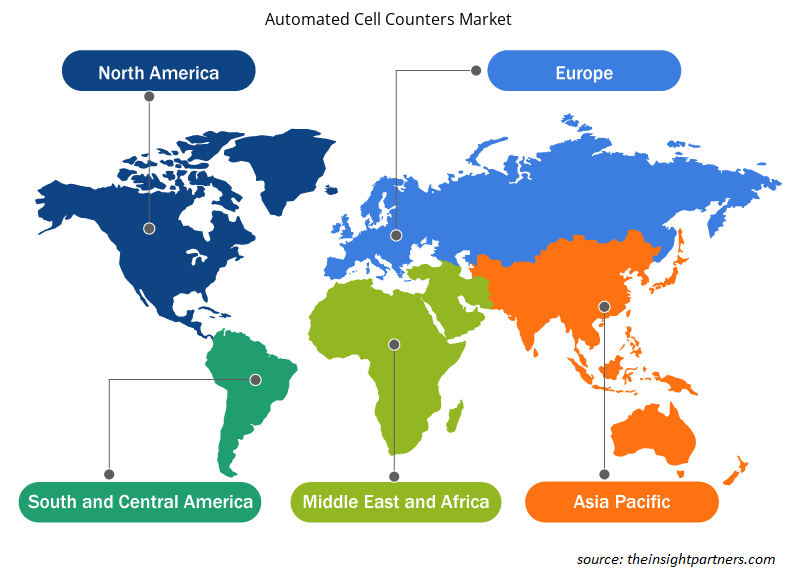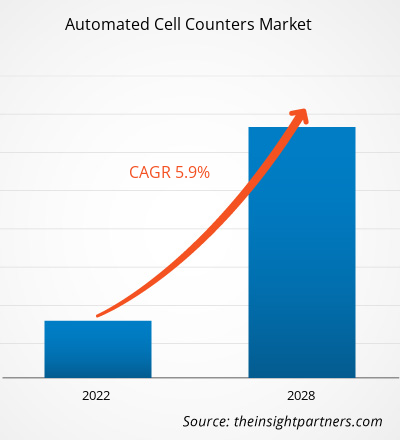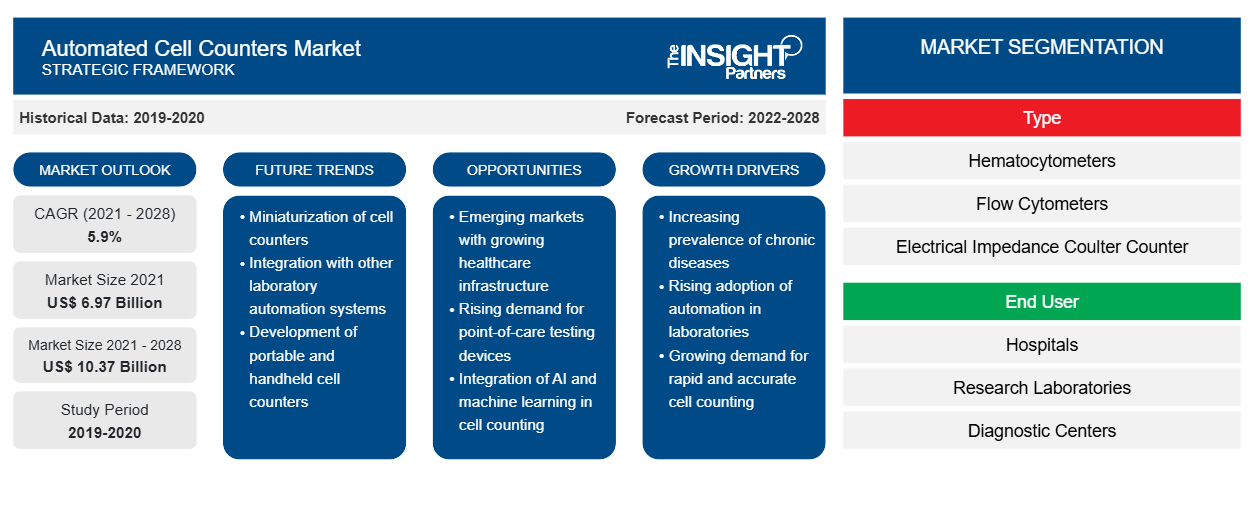自动细胞计数器市场预计将从 2021 年的 69.7429 亿美元增长到 2028 年的 103.6595 亿美元;预计从 2022 年到 2028 年的复合年增长率为 5.9%。CAGR of 5.9% from 2022 to 2028.
市场的增长归因于传染病和慢性病的高发性。
自动细胞计数器市场由 主要竞争者组成,他们采用各种策略,例如产品发布、地域扩张和技术进步。以下列出了市场的一些最新发展:
- 2021 年 4 月,Eppendorf 宣布推出一款新产品“Centrifuge 5910 Ri”,旨在提高实验室效率。这款新离心机是广受欢迎的 Centrifuge 5910 R 的后继产品,也是 Eppendorf 多用途离心机产品组合的旗舰产品,为科学家提供先进的功能,以简化和加速离心步骤。Eppendorf announced the launching of a new product, "Centrifuge 5910 Ri", designed to increase laboratory efficiency. This new centrifuge is a successor to the popular Centrifuge 5910 R, and is a flagship of Eppendorf's multipurpose centrifuge portfolio that offers scientists advanced features to simplify and accelerate the centrifugation steps.
- 2019 年 8 月,安捷伦科技公司宣布收购 Biotek Instruments,该公司是创新生命科学仪器设计、制造和分销领域的先驱。此次收购扩大了安捷伦在细胞分析领域的影响力和专业知识,并加强了该公司在庞大且不断增长的免疫肿瘤学和免疫治疗领域的地位。
- 2021 年 5 月,Bio-Rad Laboratories, Inc. 宣布与主要诊断公司建立合作伙伴关系,提供 InteliQ 产品,即一系列条形码、即装即用的质量控制管。例如,与罗氏的合作让客户能够使用 Bio-Rad 的全系列 InteliQ 产品和 Unity QC 数据管理解决方案以及客户培训和支持服务。
定制此报告以满足您的需求
您可以免费定制任何报告,包括本报告的部分内容、国家级分析、Excel 数据包,以及为初创企业和大学提供优惠和折扣
- 获取此报告的关键市场趋势。这个免费样品将包括数据分析,从市场趋势到估计和预测。
市场参与者积极参与产品创新和开发,产品批准率不断提高,推动了自动细胞计数器市场的增长。此外,随着先进技术的出现,市场在预测期内将呈指数级增长。
根据世界卫生组织 (WHO) 的报告,接受过自动细胞计数器设备使用培训的医疗保健专业人员或工人严重短缺。制药和生物技术的持续研究以及用于治疗癌症、心血管疾病、艾滋病毒/艾滋病等疾病的各种药物的开发。随着自动细胞计数器的技术进步和该仪器应用领域的增加,自动细胞计数器的使用发生了变化。自动细胞计数器的操作很困难,了解这种仪器非常重要;因此,需要一支熟练的劳动力队伍。为这种仪器准备样品是一项繁琐的工作,并且在过程中所需的消耗品也需要妥善管理。因此,缺乏能够轻松使用这些仪器的熟练劳动力,阻碍了自动细胞计数器市场的增长。
区域概况
预测期内,亚太地区的自动细胞计数器市场复合年增长率最高。毒理学检测产品和精准药物的需求旺盛、药物发现的增加以及主要市场参与者对研发的投资增加是推动亚太自动细胞计数器市场增长的因素之一。由于中国患有慢性和传染病的人口不断增加,中国的自动细胞计数器市场正在扩大。据世界卫生组织称,2018 年,约有 125 万人感染艾滋病毒,而且在年轻人中感染更为常见。据中国疾病控制中心称,约有 400 人被诊断出感染艾滋病毒。此外,2018 年,中国的艾滋病毒和艾滋病病例增加了 14%。艾滋病毒检测是通过自动细胞计数器对淋巴细胞进行绝对计数进行的。因此,艾滋病毒感染的增加正在促进自动细胞计数器市场的增长。
技术的不断发展和研究行业的不断发展使中国自动细胞计数器市场更具吸引力。例如,2018 年,Sysmex Corporation 在中国市场推出了 XS-500ix,这是一款自动血液分析仪。随着中国人口和经济的快速增长,对测试的需求也在增加。因此,中国政府推行了分配医疗资源以提高效率的政策。因此,这将增加中国对精密和高质量产品的需求,预计这将推动自动细胞计数器市场的增长。
根据印度家庭和卫生福利部 2020 年发布的《印度纵向老龄化研究》(LASI),印度三分之二的老年人患有慢性病。此外,约 23% 的老年人口患有多种疾病。心血管疾病是 45 岁以上人群的主要疾病。45-49 岁年龄组的心血管疾病比例为 19%,75 岁以上人口的比例为 37%。预计到 2030 年,非传染性疾病导致的总疾病负担中约 45% 将归因于老年人口的增长。据世界卫生组织称,印度每年约有 580 万人死于非传染性疾病。因此,老年人口中慢性病病例的增加正在推动印度自动细胞计数器市场的增长。印度政府正在实施国家癌症、糖尿病、心血管疾病和中风预防和控制计划(NPCDS),以提高人们对这些疾病的认识。这包括筛查高血压、糖尿病以及口腔癌、乳腺癌和宫颈癌,以便早期发现非传染性疾病。
因此,预计在预测期内,老龄人口的增长、慢性病病例以及控制疾病的措施将推动自动细胞计数器市场的发展。
类型洞察
根据类型,全球自动细胞计数器市场细分为血细胞计数器、流式细胞仪、电阻抗库尔特计数器和分光光度计。2021 年,分光光度计细分市场占据了最大的市场份额。与必须孵育数天才能出现菌落的点板不同,分光光度计读数可以立即转换为细胞密度。分光光度法基于培养细胞的光散射。当分光光度计中的光照射到细胞时,光线会从直线路径偏转,这些光线可能无法到达检测器。样本中的细胞数量越多,散射越轻。对疾病检测的早期诊断程序的需求不断增长,这推动了光谱仪细分市场的增长。由于疾病的增加和临床诊断程序的增长,药物发现和药物开发活动的激增推动了该细分市场的增长。政府在药物研发方面的举措增多以及分光光度计 在双分子分析中的应用增加推动了该领域的增长。
预计血细胞计数器细分市场在预测期内的复合年增长率最高。血细胞计数器最初是为计数血细胞而开发的。它已广泛用于计数所有类型的细胞,包括单细胞生物,如酵母、原生动物和细菌。血细胞计数器是最具成本效益的细胞计数方法。血细胞计数器可重复使用,可轻松与实验室中的其他常用工具(如光学显微镜)一起使用。导致贫血、地中海贫血、淋巴瘤、白血病和其他疾病的血细胞疾病发病率增加推动了该细分市场的增长。例如,根据世界卫生组织的数据,2019 年全球贫血患病率为 29.9%,相当于 50 多万 15-49 岁女性。此外,2019 年全球 6-59 个月儿童贫血患病率为 39.8%,相当于 2.69 亿名贫血儿童。在发展中国家,血细胞计数器用于快速有效地计数细胞以检测贫血。因此,使用血细胞计数器检测各种血液疾病预计将推动该领域从 2022 年到 2028 年的增长。
在自动细胞计数器市场运营的公司采用产品创新战略来满足全球不断变化的客户需求,这也使他们能够在市场上保持自己的品牌名称。
全球自动细胞计数器市场 – 细分
自动细胞计数器市场按类型、最终用户和地域细分。根据类型,市场细分为血细胞计数器、流式细胞仪、电阻抗和分光光度计。根据最终用户,市场分为医院、研究实验室、诊断中心和其他。按地域细分,自动细胞计数器市场细分为北美(美国、加拿大和墨西哥)、欧洲(英国、德国、法国、意大利、西班牙和欧洲其他地区)、亚太地区(中国、日本、印度、澳大利亚、韩国和亚太其他地区)、中东和非洲(阿联酋、沙特阿拉伯、非洲和中东及非洲其他地区)以及南美洲和中美洲(巴西、阿根廷和南美洲和中美洲其他地区)。
自动细胞计数器市场区域洞察
Insight Partners 的分析师已详细解释了预测期内影响自动细胞计数器市场的区域趋势和因素。本节还讨论了北美、欧洲、亚太地区、中东和非洲以及南美和中美洲的自动细胞计数器市场细分和地理位置。

- 获取自动细胞计数器市场的区域特定数据
自动细胞计数器市场报告范围
| 报告属性 | 细节 |
|---|---|
| 2021 年市场规模 | 69.7 亿美元 |
| 2028 年市场规模 | 103.7亿美元 |
| 全球复合年增长率(2021 - 2028) | 5.9% |
| 史料 | 2019-2020 |
| 预测期 | 2022-2028 |
| 涵盖的领域 | 按类型
|
| 覆盖地区和国家 | 北美
|
| 市场领导者和主要公司简介 |
|
自动细胞计数器市场参与者密度:了解其对业务动态的影响
自动细胞计数器市场正在快速增长,这得益于终端用户需求的不断增长,而这些需求又源于消费者偏好的不断变化、技术进步以及对产品优势的认识不断提高等因素。随着需求的增加,企业正在扩大其产品范围,进行创新以满足消费者的需求,并利用新兴趋势,从而进一步推动市场增长。
市场参与者密度是指在特定市场或行业内运营的企业或公司的分布情况。它表明在给定市场空间中,相对于其规模或总市场价值,有多少竞争对手(市场参与者)存在。
在自动细胞计数器市场运营的主要公司有:
- 艾本德
- 赛默飞世尔科技公司
- Countstar 公司
- Bio-Rad 实验室有限公司
- F. 霍夫曼-罗氏有限公司
免责声明:上面列出的公司没有按照任何特定顺序排列。

- 获取自动细胞计数器市场顶级关键参与者概述
公司简介
- 艾本德
- 赛默飞世尔科技
- Countstar 公司
- Bio-Rad 实验室有限公司
- F. 霍夫曼-罗氏有限公司
- 化学计量公司
- 对齐遗传学
- 贝克曼库尔特公司(丹纳赫)
- 纳米恩泰克
- 奥林巴斯公司
- 默克集团
- 希森美康股份有限公司
- 安捷伦科技公司
- 雅培
- Nexcelom 生物科学有限责任公司
- 历史分析(2 年)、基准年、预测(7 年)及复合年增长率
- PEST和SWOT分析
- 市场规模、价值/数量 - 全球、区域、国家
- 行业和竞争格局
- Excel 数据集
近期报告
相关报告
客户评价
购买理由
- 明智的决策
- 了解市场动态
- 竞争分析
- 客户洞察
- 市场预测
- 风险规避
- 战略规划
- 投资论证
- 识别新兴市场
- 优化营销策略
- 提升运营效率
- 顺应监管趋势





















 获取免费样品 - 自动细胞计数器市场
获取免费样品 - 自动细胞计数器市场